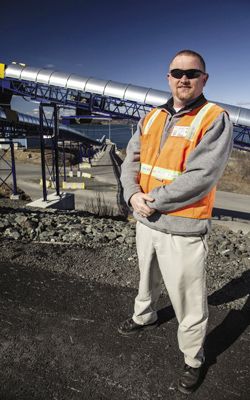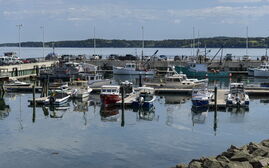Nearly $25 million in upgrades position Maine's ports for more business
With nearly 3,500 miles of coastline, deep coastal waters and an eastern prominence, Maine has always looked to its ports to measure the economic tide.
As new industries and opportunities arise in the state, Maine's three surviving ocean ports are testing the waters and positioning themselves to capitalize on growth industries ranging from wood chips and pellets to propane and pregnant cattle.
The state's ports saw a "precipitous decline" in traffic in 2009, but have since rebounded thanks in part to $14 million in federal stimulus grants.
"Volumes are up from last year and everything is trending in the right direction, but we are still recovering from the 2009 debacle," says John Henshaw, Maine Port Authority executive director.
Historically a stronghold of maritime commerce, Maine's ports have seen opportunity sail past the craggy coast to better equipped and connected ports over the last century, finding themselves dependent on a few major exporters.
This dynamic played out dangerously in 2009 when Baileyville's Woodland Mill, then owned by Canadian paper producer Domtar Corp., shut down for seven weeks. The mill was not only Washington County's largest employer, but also the primary customer for the port of Eastport.
The mill has improved its financial standing and recalled workers since being bought out, but the closure was a wake-up call for the port, says Henshaw.
Port officials took the scare as an opportunity to reassess their lack of diversification and soon identified a growth industry that Eastport was uniquely suited for — the rising demand for woody biomass in Europe. "That's when they decided to invest in a bulk cargo handling system," says Henshaw.
The $8 million dollar investment —which included new loading space, a warehouse and a belt conveyor system — paid off recently as the port announced a partnership with Timber Biofuel Venture, an exporter of wood chips with the capacity to ship 200,000 tons of wood chips a year and an eye on biofuel-hungry European markets. Timber Biofuel Venture will lease space at the port's bulk storage yard and pay a per-ton fee based on wood chips shipped.
"It was a combination of state, federal and port authority money coming together to create this new capacity that they didn't have before and [that] allows them to diversify their cargos," says Henshaw.
From cruise ships in Portland to propane tanks in Searsport, Maine's ports are fighting to drum up new business and revenue. Here's an update.
Eastport: Got milk?
As the country's easternmost city, Eastport is an unlikely site for a cattle drive. There are more lobster boats than covered wagons and around here the boots are generally of the Bean, not cowboy, variety.
But since the summer of 2010, Eastport has seen over 20,000 head of cattle move through the port. Its burgeoning livestock trade was jumpstarted by a rare, temporary approval from the U.S. Department of Agriculture to export cattle — the only New England port authorized to do so. "It could mean big things for the port," said Chris Gardner, Eastport Port director in a press release.
The port's first cattle shipment in the summer of 2010 saw nearly 500 cattle packed into newly-patented Comfort Animal Transport Suites for shipment to Turkey, a country trying to expand its dairy industry.
Shipped by Texas-based Sexing Technologies, 470 cows were loaded onto Dutch cargo freighter Artisgracht in Eastport, and 472 cows arrived safely in Turkey, with two calves having been born during the trans-Atlantic journey, according to Gardner.
Maine's relative proximity to the Middle East and Russia, two large importers of dairy cows, makes Eastport an ideal site for livestock exports, according to Gardner. Cattle spend less time in transit, cutting down on stress for the animals already belabored by the rigors of pregnancy.
"The livestock business has been very active in the last year," says Henshaw. "Eastport just had ships going to the right places — Turkey, Russia. We've already been carrying [wood] pulp to those places and were able to put together an opportunity that worked."
Turkey has implemented particularly harsh import standards to combat disease, and hopes the more robust stock of American cattle will help to boost the bloodlines of Turkish cattle, a population plagued by birth defects and poor milk quality due to inbreeding, according to Sexing Technologies.
Eastport's growing livestock export trade benefits from Maine's status as a state free of blue tongue disease. The insect-borne, viral disease can be fatal to livestock or require long periods of recovery, and can be a major impediment to international livestock exports.
In November, the USDA extended inspection contracts with the port, assuring that there would be federal officials on hand to inspect the cattle before shipment and boosting the viability of the cattle export market in Maine. Gardner says the port will continue to work on securing a permanent livestock permit.
Portland has also been trying to secure a license to ship livestock, says Henshaw.
Searsport muscle
Located at the heart of Penobscot Bay, Searsport's Mack Point Marine Intermodal Cargo Terminal benefits from calm waters and an on-site rail yard connecting the port to the Montreal, Maine & Atlantic Railway.
As of February, the port also boasts Maine's largest mobile harbor crane. With a lifting capacity of 144-metric tons, the $4.2 million crane was purchased with federal TIGER funds and is owned by the state, with Sprague Operating Resources overseeing its use.
The new crane will increase the port's heavy-lift ability, increasing efficiency for moving bulk materials and heavy project cargo such as transformers, paper-making machines and wind turbine components, according to the Maine Department of Transportation. "It's nice to see, we made the investment, applied for federal money and now we're going to see its first use in May" during the unloading of wind turbine parts, says Henshaw.
The Mack Point property, with its 90,000-square-foot warehouse and 30 fuel tanks with a capacity of 1.6 million barrels, is now largely owned by Sprague Energy, with Irving Energy leasing some of the property from the state.
But some area residents have mobilized around a proposed liquid propane gas terminal that would add a 22.7-million-gallon, 137-foot propane tank to the port's currently modest 50-foot skyline. Proposed by Denver-based DCP Midstream, the liquid propane gas terminal could add four to six propane tanker trips annually, according to Sprague Energy.
In early March, Searsport voters overwhelmingly rejected a proposed moratorium on the new tank, with voters citing increased revenue from property taxes and the prospect of adding jobs in a county that has seen its unemployment rate double in the last decade, according to the Maine Center for Workforce Research and Information.
Searsport currently sees 160 visits to the port annually to unload heating oil, diesel, gasoline and kerosene. A considerably smaller fleet of 12 to 36 vessels comes to unload bulk commodities like road salt, gypsum and windmill components, according to Sprague Energy.
Land of ports
Portland's port activity is more diversified than the state's other major shipping ports. With 11 terminals stretching from the Portland Pipeline facility in South Portland to the Sprague Energy terminal at the mouth of the Fore River, it sees everything from oil and fish to bulk containers and cruise ships.
After a four-year stretch of dormancy, Portland's International Marine Terminal welcomed startup shipping company American Feeder Lines to the Commercial Street facility last summer. The terminal had been closed since mid-2007 when Icelandic shipping company Eimskip stopped calling on the port.
Since then, the terminal has seen a $5 million influx in federal transportation funds, money the Port Authority put into expanding the pier's capacity by 5,000 square feet. The infrastructure improvements to the port will lead to a doubling of the pier's weight capacity and make for a very busy terminal, says Henshaw. "It's an interesting juxtaposition to see construction and shipping working together at the same time," he says.
The International Marine Terminal has been leased to the Maine Port Authority by the city of Portland since 2009.
Imports and exports aside, Portland's harbor also caters to one of the state's most precious natural resources: tourists.
Having sunk $6 million from a federal bond package into the project, Portland's mega berth was officially unveiled at the Ocean Gateway Terminal's Pier II late last summer. The berth will allow Portland to host some of the world's largest cruise ships.
"Before, with the extreme tides, we were having issues," says Robert Leeman, maritime manager for the Port of Portland. "This is going to take all those issues out of the picture."
But the results won't be immediate, says Leeman. Portland is actually projected to see passenger days decrease this year by 19% over last year owing to an 18-month lag between cruise ship scheduling and the port's recent improvements. "It's not directly affecting the number of ships this year because these have been scheduled for 18 months, but it will affect future sales and hopefully we will get some more cruises coming in," he says.
While Henshaw says cruise ship visits to New England have been fairly stagnant in recent years, he says the industry has grown "tremendously" since the early 2000s.














Comments